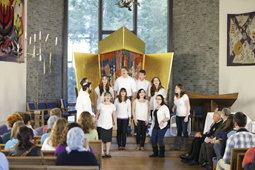Chapels' rededication underscores traditions of tolerance toward all faiths
$1 million renewal project refurbished Jewish, Muslim and Christian spaces
The first stop — a response to the anti-Muslim sentiment sweeping the country — was the Muslim Prayer Center.
About 30 people of various faiths gathered in the center on the ground floor of Usdan Monday afternoon, Sept. 13, to begin a campus pilgrimage of sorts. The Muslim center and the three chapels — Protestant, Catholic and Jewish — were rededicated in succession, marking the completion of a refurbishment that cost about $1 million. Chaplains representing the four faiths, Imam Talal Eid, Rabbi Elyse Winick, Father Walter Cuenin and Protestant Chaplain Alex Kern, conducted the program, which was attended by President Jehuda Reinharz.
At the first stop, Imam Talal Eid stood along side his colleagues among prayer rugs laid out on a diagonal facing Mecca. He demonstrated Muslim prayer rituals and then addressed the crowd, saying that he has fielded questions from prospective Muslim students. “They call,” he said, “and ask ‘How will I celebrate Ramadan? How are we going to do Friday prayers?’ I tell them, ‘Don’t worry, just come’.” He says many are surprised to discover that “this worship place [for Muslims] is the largest worship place in the area for any university.”
Before the renovations, preparing for Muslim prayers was problematic. The ritual washing of the feet called "ablution" had to be done in a public restroom down the hall — something Eid said was embarrassing for all. Part of the renovation involved building a special floor-level tile tub with low spigots in the kitchen of the Prayer Center. “It was a major positive step,” said Eid. “The women and young men too could use it without hesitation.”
The crowd walked next down the hill to the three original campus chapels, which encircle a heart-shaped pond said to symbolize the heart of God. The chapels, constructed to suggest open Bibles, were dedicated in 1955 and reflect the religions of the time — Protestant, Catholic and Jewish — “because, 50 years ago, that was all that there was for religion in America. That was sort of the standard trio. We didn’t think about Muslims, let alone Buddhists or anybody else,” said Cuenin, who is coordinator of the campus' interfaith chaplaincy. "When they did that 50 years ago, it was a very big step. They debated whether to have one chapel that would be used by all religions, but said no, each religion should have its own specific place."
Rabbi Winick, a 1986 Brandeis graduate, said the university has always sought not to discriminate, and that “had there been a large enough Muslim community, I’m confident Brandeis would have had a Muslim Chapel.”
Cuenin noted that the Protestant chapel, the second stop on the rededication procession, was named in memory of Justice John Marshall Harlan of the U.S. Supreme Court, who in 1896 was the only justice to vote against the Jim Crow laws which codified racial segregation. The decision to honor Harlan was “a very big sign of Brandeis’s commitment to justice,” says Cuenin, because the naming was decided at a time when segregation was still widespread in the country. A stirring “Prayer of Rededication” was delivered off-the-cuff by Elena Wilson, who works in academic services, and song sheets were distributed so the mixed-religion crowd could sing together. Protestant chaplain Alex Kern, a Quaker, led a brief service, and the audience and chaplains sang “Amazing Grace” together.
“I felt elated by the way I sat up there between an Imam and a Catholic priest and they were singing right along with me,” said Rabbi Winick afterward. “That was a deeply spiritual moment for me. And where else? Where else but Brandeis?”
As the procession continued, classes ended for the day and the crowd doubled in size.
Next came the Bethlehem Chapel, where Father Walter Cuenin pointed out various features of the Catholic sanctuary, including a crucifix that doesn’t depict a suffering Jesus, “but a welcoming Jesus,” with arms gently outstretched to the viewer. Cuenin showed that one arm of the cross itself was also slightly raised, “to welcome everyone.” A rainbow peace banner hung in the hallway, a sign that the doors to this chapel are open to gay people. Cuenin said he welcomes those who have faith, or “Catholics barely holding on. Everyone is welcome.” He also offered some history.
“When the Catholic chapel was built," he said, "there were Catholics in Boston protesting it, because how could we have a mass in a Catholic chapel on a Jewish campus?” But the sister of the Boston Cardinal was herself married to a Jewish man, “so Cardinal Cushing came himself for the first mass, to make it clear that this was good.”
At the Berlin Chapel, Rabbi Winick told the crowd that 22 years ago, in that very room, she was married to a man she met as a student at Brandeis. Every once in awhile, she said, congregants still come across a yarmulke with her wedding name and date inscribed inside. There were prayers, a choir performed two songs, and then one final ritual was carried out. Everyone stepped outside and a traditional mezuzah was affixed to the chapel’s door post. The mezuzah contains a tiny scroll, the Rabbi said, blessing all who come in and all who go out.
The first dedication of the chapels was just 10 years after the end of World War II. The rabbi pointed out that back on that sunny day in 1955, much care had gone into avoiding the appearance of any religion dominating others. The chapels encircling the heart-shaped pond were built in such a way, she said, that “the shadow of one should never fall upon the others.”
Categories: Humanities and Social Sciences, Student Life






